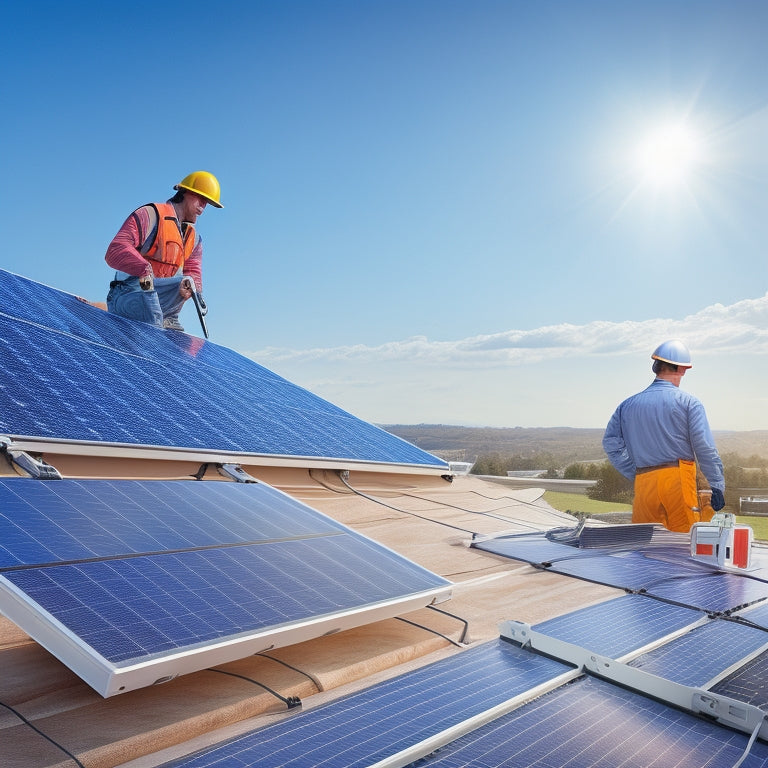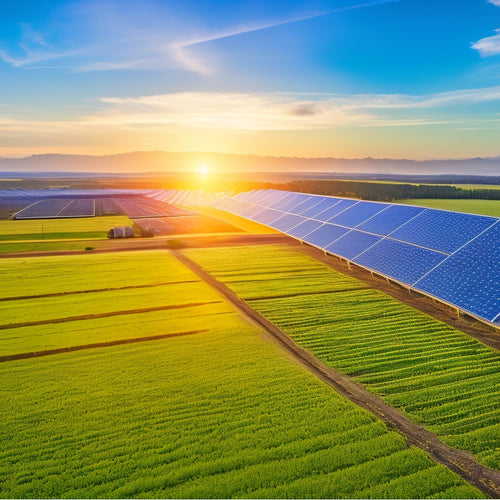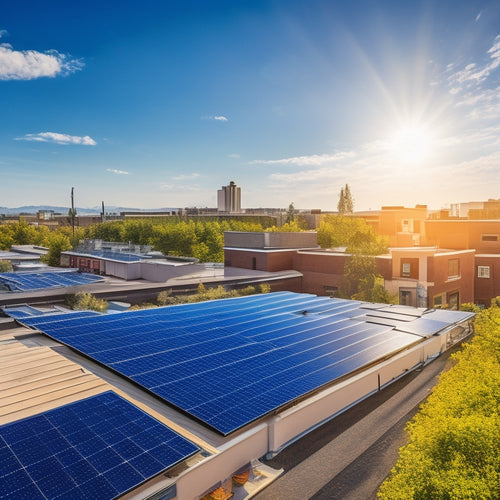
Real Cost of Solar Panels: A Step-by-Step Installation Guide
Share
You're considering installing solar panels, but you want to know the real cost. A typical residential solar panel system will set you back around $15,000 to $30,000, but don't let that sticker shock you. With rebates, tax credits, and long-term energy savings, you can recoup up to 50% of the upfront cost and start saving money on your energy bills within a few years. You'll need to assess your energy needs, choose the right equipment, and select a qualified installer to get the job done. As you maneuver through the installation process, understanding the breakdown of costs, incentives, and ongoing maintenance expenses is key to making an informed decision - and getting the most out of your investment.
Key Takeaways
- Assessing energy needs is crucial to determine the required solar panel system size and type, ensuring optimal energy generation and cost-effectiveness.
- Choosing the right equipment, including solar panels, inverters, and mounting hardware, affects system efficiency, performance, and overall cost.
- Selecting a qualified installer with necessary certifications, experience, and insurance is vital for a successful and safe installation process.
- Installation costs vary based on location, system size, and installer, with a typical breakdown including material and labor costs, permit fees, and company markup.
- Ongoing maintenance expenses, including regular cleaning, are essential to ensure optimal solar panel performance and extend the system's lifespan.
Understanding Solar Panel Costs
When evaluating a solar panel installation, one of the most important factors to weigh in on is the cost. You'll want to examine not only the upfront expense but also the long-term savings and financing options available.
Solar incentives, such as tax credits and rebates, can greatly reduce the initial cost. Additionally, you'll benefit from energy independence, reducing your reliance on the grid and enjoying lower electricity bills.
System efficiency is vital, as it directly impacts the amount of energy generated. A well-designed system with high-efficiency panels will maximize your energy output.
Grid connection is also necessary, allowing you to sell excess energy back to the grid and offset your consumption. Environmental benefits are a noteworthy bonus, as solar energy is a clean and renewable source.
To fully understand the costs, it's important to factor in the long-term savings. While the initial investment may seem substantial, the reduced energy bills and potential increase in property value will pay off over time.
Assessing Your Energy Needs
Your energy needs are a vital factor in determining the size and type of solar panel system required for your property. To accurately evaluate your energy needs, you'll need to calculate your energy consumption. This involves examining your past energy bills to determine your average daily energy usage in kilowatt-hours (kWh).
You can do this by adding up the total kWh used per month and dividing it by 30 to get your daily average. This will give you a clear representation of your energy consumption patterns, including peak usage times and seasonal fluctuations.
Understanding your energy consumption is essential in determining the required solar capacity for your system. A solar panel system that's too small won't meet your energy needs, while one that's too large will be a waste of resources.
Choosing the Right Equipment
With your energy needs accurately assessed, you're now ready to select the right equipment for your solar panel system. This involves choosing the most suitable solar panels, inverters, and mounting hardware for your specific requirements. Panel efficiency, a measure of how well a panel converts sunlight into electricity, is an essential factor in this decision. Higher-efficiency panels may be more expensive, but they can provide more power per unit area.
Inverter types also vary, with string inverters being the most common. Microinverters and power optimizers offer more granular control over individual panels but come at a higher cost.
| Equipment Component | Key Considerations |
|---|---|
| Solar Panels | Panel efficiency, durability, warranty |
| Inverters | Inverter type, maximum power output, compatibility |
| Mounting Hardware | Durability, adjustability, roof compatibility |
Selecting a Qualified Installer
Get ready to hand over the reins to a professional, as selecting a qualified installer is essential to guaranteeing your solar panel system is installed correctly and efficiently.
You'll want to research and vet potential installers thoroughly to guarantee they've the necessary qualifications and experience. Check for certifications like NABCEP (North American Board of Certified Energy Practitioners) and look for installers with a track record of successful projects.
Read customer reviews and ask for referrals to get a sense of an installer's work quality, communication style, and customer service. You can also check with the Better Business Bureau or local consumer protection agencies to see if there have been any complaints filed against an installer.
Additionally, make certain the installer has the necessary licenses and insurance to work in your state and on your type of property.
Permits and Installation Timelines
You'll need to secure necessary permits before installation begins, which involves submitting an application to your local government and waiting for approval.
The timeline for installation will depend on the complexity of the project and the efficiency of your installer, but you can typically expect it to take several weeks to a few months.
After installation, your system will need to pass a final inspection and receive approval from your utility company before it can be activated.
Permit Application Process
Obtaining the necessary permits is an essential step in the solar panel installation process. You'll need to confirm your project complies with local regulations, which vary depending on your location.
Begin by researching the specific requirements for your area, including zoning requirements and environmental impact assessments. You may need to submit application forms to your local government or utility company, which will review your project's design and installation plans.
Be prepared to provide detailed information about your solar panel system, including its size, type, and installation location. You may also need to demonstrate compliance with local building codes and electrical safety standards.
The permit application process can be complex, so it's a good idea to work with a licensed solar installer who's experienced in guiding you through these requirements. They can help you gather the necessary documents and submit a complete application package.
Timeline for Installation
Once your permit application is complete, it's time to focus on the timeline for installation. This phase typically takes several weeks to a few months, depending on the complexity of the project and the availability of the installation team.
You'll need to evaluate the following key factors that impact the installation timeline:
-
Site preparation: The installation team will assess your roof's condition, ensuring it can support the weight of the solar panels. They'll also clear the area around your home to facilitate easy access.
-
Weather factors: Inclement weather, such as heavy rain or extreme cold, can delay installation. Your installation team will work with you to schedule a convenient time, keeping in mind any weather-related setbacks.
-
Installation scheduling: The installation team will coordinate with you to schedule a convenient time for the installation, ensuring minimal disruption to your daily routine.
- Material delivery and staging: The installation team will arrange for the delivery and staging of the necessary materials, ensuring everything is in place before the installation begins.
Inspection and Approval
With the installation timeline in place, attention turns to the crucial phase of inspection and approval, where permits and installation timelines converge.
You'll need to obtain necessary permits from local authorities, which involves submitting your solar panel installation plan for review. This process typically takes a few weeks to a few months, depending on the jurisdiction and workload of the permitting office.
During this phase, you'll undergo solar panel inspections to confirm your system meets local building codes and safety standards. Inspectors will verify that your installation complies with electrical and fire safety regulations, as well as local zoning ordinances.
You'll need to address any issues or deficiencies identified during the inspection process before receiving final approval.
The approval process typically involves a series of steps, including plan review, installation inspection, and final authorization.
Once you've obtained all necessary permits and approvals, you can proceed with the installation of your solar panel system.
Be sure to keep detailed records of your permits, inspections, and approvals, as these will be required for future maintenance and potential system upgrades.
Breaking Down Installation Costs
When calculating the total cost of your solar panel installation, you'll need to take into account three main components: material and labor costs, which encompass the expenses of the solar panels, inverters, and installation workforce; permit and inspection fees, which are paid to your local government and inspectors; and the installation company's markup, which covers their overhead and profit.
These costs can vary depending on your location, system size, and installation company. Understanding how these costs break down will help you make an informed decision when selecting a solar panel installation company.
Material and Labor Costs
You're likely wondering what makes up the bulk of your solar panel installation costs. The answer lies in material and labor costs, which account for a considerable portion of the overall expense.
When it comes to materials, you'll need to take into account the following:
-
Solar panels: The cost of high-quality solar panels can vary depending on the brand, efficiency, and wattage.
-
Mounting hardware: This includes the racking system, clamps, and tracking equipment that secure your solar panels to your roof or ground.
-
Inverters: These convert DC power from your solar panels to AC power for your home.
- Electrical components: This includes wiring, connectors, and other electrical materials needed for the installation.
Material sourcing and labor negotiation play a vital role in determining these costs. Your installer's relationships with suppliers and their ability to negotiate prices can greatly impact your bottom line.
Additionally, the complexity of the installation, such as the need for custom mounting solutions or additional electrical work, can also drive up labor costs.
Permit and Inspection Fees
Compliance with local regulations is an important aspect of solar panel installation, and it comes at a cost. You'll need to obtain permits and undergo inspections to guarantee your system meets safety and building codes. The fees associated with these requirements vary depending on your location and the type of installation.
Understanding the fee structures and application procedures is vital to budgeting for your solar panel installation. Here's a breakdown of the typical permit and inspection fees:
| Fee Type | Average Cost | Purpose |
| Building Permit | $500-$1,000 | Verify compliance with local building codes |
| Electrical Permit | $200-$500 | Guarantee safe electrical connections |
| Inspection Fee | $100-$300 | Verify system meets safety and building codes |
Keep in mind that these fees can vary depending on your location and the complexity of your installation. Be sure to factor these costs into your overall budget to avoid surprises down the line. By understanding the permit and inspection requirements, you can guarantee a smooth and compliant installation process.
Installation Company Markup
Beyond permit and inspection fees, another significant cost factor in your solar panel installation is the markup added by the installation company. This markup can vary greatly depending on the company's installation pricing strategies and contractor profit margins.
As you research and compare quotes from different installers, it's crucial to comprehend how they calculate their markup to guarantee you're getting the best deal.
Here are some key factors that influence an installation company's markup:
-
Overhead costs: The company's operational expenses, such as office rent, marketing, and administrative salaries, are factored into the markup.
-
Labor costs: The cost of hiring and training skilled laborers, as well as their benefits and insurance, contribute to the markup.
-
Equipment and material costs: The cost of high-quality solar panels, inverters, and mounting hardware is marked up to secure a profit.
- Profit margins: The company's desired profit margin is added to the overall cost of the installation, which can vary depending on the company's business goals and target market.
Incentives and Tax Credits
Government incentives and tax credits play a notable role in making solar panel installation more affordable and accessible to homeowners and businesses alike. You can greatly reduce the upfront cost of solar panel installation by taking advantage of these incentives.
| Incentive Type | Description |
|---|---|
| Federal Incentives | 26% tax credit on total solar panel installation cost through the Solar Renewable Energy Credits (SRECs) program |
| State Tax Credits | Varying credits on state taxes, e.g., 10% in California, 25% in Arizona |
| Local Rebates | Utility company rebates, e.g., $0.50 per watt in San Francisco |
You can also investigate financing options, such as Property Assessed Clean Energy (PACE) financing, to further reduce the financial burden. Additionally, you may be eligible for property tax exemptions, which can save you money on your annual property taxes. Net metering programs also allow you to sell excess energy back to the grid, offsetting your energy costs. By leveraging these incentives, you can make solar panel installation a more viable and cost-effective option.
Ongoing Maintenance Expenses
One essential aspect of solar panel installation that's often overlooked is the ongoing maintenance expenses that come with it.
As a solar panel owner, you'll need to factor in these costs to guarantee your system runs efficiently and effectively.
You'll need to take into account the following expenses:
-
Cleaning schedules: Regular cleaning is vital to maintain your solar panels' performance. You may need to hire a professional cleaning service or invest in cleaning equipment, which can cost around $300-$500 per year.
-
Component replacements: Over time, certain components like inverters or inverters may need to be replaced. These replacements can cost anywhere from $1,000 to $3,000.
-
System upgrades: As technology advances, you may want to upgrade your system to improve its performance or add new features. Upgrades can cost $2,000 to $5,000 or more.
- Monitoring tools: To track your system's performance and identify potential issues, you'll need monitoring tools, which can cost around $100 to $300 per year.
Frequently Asked Questions
Can I Install Solar Panels on a Metal or Clay Tile Roof?
You'll face unique installation challenges on a metal or clay tile roof, requiring specialized mounting systems and careful planning to guarantee roof compatibility, so it's crucial to consult with a professional installer to determine the best approach for your specific roof type.
How Do I Ensure My System Is Hurricane-Resistant?
When a hurricane's fierce winds howl, you'll want your solar panel system to be a fortress, not a fragile leaf. Guarantee it's hurricane-resistant by selecting panels with high hurricane ratings and insisting on installation techniques that secure them like a vice to your roof.
Are There Any Specific Requirements for Commercial Solar Installations?
When installing commercial solar panels, you'll need to obtain commercial permits, which vary by state and locality, and take advantage of installation incentives, such as tax credits, to maximize your return on investment.
Can I Monitor My Solar Panel Performance Remotely?
You're not just tracking your solar panel's performance, you're obsessed with it! Luckily, remote monitoring systems let you do just that, giving you real-time updates on energy production, performance tracking, and alerting you to any issues, so you can optimize your system for maximum power.
Do Solar Panels Work During Power Outages?
You're wondering if solar panels work during power outages; unfortunately, they don't, as they're grid-tied and shut down for safety reasons. However, you can investigate power outage solutions like battery backup systems to maintain solar panel efficiency during outages.
Conclusion
You've made it to the final step of your solar panel installation process. Now, you're likely wondering if the upfront cost will pay off in the long run. The theory is that solar panels will save you money on your energy bills, but is it true? According to the National Renewable Energy Laboratory, solar panels can save homeowners between $400 and $1,000 per year on their electricity bills. With an average system lifespan of 25 years, that's a significant return on investment.
Related Posts
-

Solar Power for Reducing Carbon Footprint
Solar power is an effective strategy for reducing your carbon footprint. By adopting solar energy, you can cut greenh...
-

How to Reduce Home Energy Bills
To reduce your home energy bills, start by investing in energy-efficient appliances and upgrading your insulation. Lo...
-

Solar Energy Solutions for Small Businesses
Switching to solar energy can be a game changer for your small business. You'll enjoy significant cost savings on mon...


